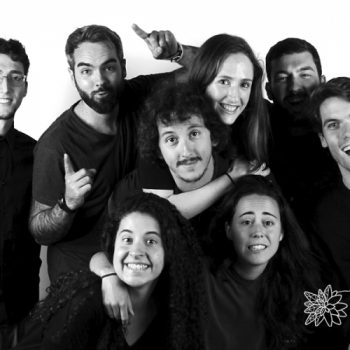
What is Cultural Transition? and How to Deal with it
Today on the blog, we are very excited to have a guest writer, Marta Zielinska. Marta describes herself as “a psychologist by education, HR/Mobility professional by employment and an expat by choice.” She runs the website Project Abroad, where she employs her personal expertise in business, psychology, and intercultural experiences to help professional expats get more confident and comfortable in the new culture, so that they can build successful international careers and lives.
We ‘met’ Marta on Instagram, where she provides very meaningful advice and insights on intercultural experiences and we were only more impressed when we checked out the extensive resources on her blog. She is the perfect person to shed light on cultural transitions and in this post she walks us through the example of an expat adapting to Spain. We hope you will enjoy her guest post and be able to apply some of the strategies she lays out in order to thrive here in Spain or wherever you find yourself in intercultural experiences.
Without further ado, we bring you Marta:
When we talk about an international transition, it’s usually also a cultural one as we’re going to live in a place that is culturally different from where we come from and what our cultural point of reference is.
We have to learn new scripts of behaviours (the famous dos and donts!), find our way around in the new city, figure out how to do sometimes the simplest tasks.
But these are just the surface things that we need to do. The longer we spend in the new country, the more we realise there also needs to be a certain mindset shift to make things work. Living abroad is also an amazing opportunity to understand another culture more deeply, and expand your skill set to include new communication and behavioural styles. That in turn allows you to be a more versatile employee, as well as more resilient in dealing with uncertainty within other life transitions too.
 The reality unfortunately is that it’s often not as easy and effortless as it may seem from the social media. The amount of changes that are happening in our lives, both professional and personal, when we move abroad is massive, and we may be thrown off by it all. After a moment of “honeymoon” in the new place, the differences can start feeling less fascinating and more frustrating.
The reality unfortunately is that it’s often not as easy and effortless as it may seem from the social media. The amount of changes that are happening in our lives, both professional and personal, when we move abroad is massive, and we may be thrown off by it all. After a moment of “honeymoon” in the new place, the differences can start feeling less fascinating and more frustrating.
Surprisingly for some, this can also hit you if you’re moving to a seemingly similar country, like one that speaks the same language (eg. US to the UK, or Chile to Spain), or even to a bordering country which is technically not far geographically but can be far off culturally (eg. Germany to France or Switzerland to Poland).
So… what can you do when you get overwhelmed with the novelty and don’t quite know what to do next to adapt? Good news is that you can make the transition easier on yourself with a few mindful steps. Let’s see how Katie, an American who moved to Spain, dealt with the transition.
Let’s meet Katie
Katie has been to Spain a few times as a tourist before, loved the climate, loved how relaxed it felt. When the opportunity came up to go for an assignment there – she took it and was very excited for her Spanish adventure.
Very quickly, it became apparent to her that her tourist experience did not quite reflect the working environment. In fact, many elements of the working culture felt annoying and confusing for her. She felt unsupported, unproductive, she felt like she was failing.
While the two-hour lunch sounded lovely during her holidays, when it was a break at work during which basically no business was discussed, she started judging this behaviour through her own cultural lens. Unproductive, waste of time, lazy, They would just drink coffee and wine all day – were just a few phrases that came up.
Another thing that was a real nuisance for Katie was the fact that she felt like she couldn’t always contribute to the discussions as easily as she could back home. When she was challenging the opinions of a manager, people would “look at her funny.” She was more often just told what to do. When she wanted to reach out to one of the more senior managers needing his expertise, she was advised to go through his assistant. Phrases that came up here included: ridiculous, slow, self-important, unsupportive.
Labelling some of the challenging behaviours as such, as you can imagine is not the most productive strategy to deal with cultural transition. If we stop here, we are staying in the shock/problem/venting mode.
How can you start moving towards the problem-solving mode and focus on the solutions?
 Awareness of self
Awareness of self
Self-awareness is the first step. In order to even notice or decide that there are some actions to take, you first need to be aware of what your starting point is!
• Of what feelings you are actually feeling.
• Of the reality that you’re dealing with.
• Of the main challenges that seem to be frustrating and energy-draining.
• Of the things that were supposed to be great abroad and now actually make you want to go back home.
• And finally – of your own culture and values.
Starting with exploring yourself and challenging your notions of ‘normal’ is usually the best. We often are blissfully unaware of the cultural patterns we live in, and only notice them when we are taken out of that culture, in the same way that the fish does not notice water until it’s taken out of it gasping for air.
Just like Katie was.
She knew what was wrong, she specified a bit more what feelings these situations were bringing up in her. Next step was to go deeper and understand the underlying reasons for why she was feeling that way, so that she could work with the source.
Coming up with a strategy and way forward
When you know how you feel, what feels uncomfortable, weird or stupid, it’s time to learn more about the other perspective and use this knowledge to nurture the solution-oriented approach. There’s almost always a perspective that is different from your own – zooming in (to our feelings and preferences) and out (to see other cultural trends) is a key skill that global professionals need these days to be successful.
And this is exactly what Katie did. She found out about the concept of cultural dimensions, learnt more about the cultural trends that exists in the US and in Spain and, most importantly, how they compare to her own behaviours and preferences.
She found out that Spanish society is more relationship-focused (“I know and like you, and therefore I trust you”), while the US is more task-focused (“You do your job well, and therefore I trust you”) when it comes to building trust and doing business.
 It was a lightbulb moment for her and a big mindset shift.
It was a lightbulb moment for her and a big mindset shift.
It turned out that what she previously quite harshly perceived as being lazy and unproductive, can actually mean building strong business relationships and trust. It became clear to her that if she wanted to be effective and get things done, it would be extremely hard with just ‘doing her job well.’ She needed to find a way to change her mindset about what productive and professional mean.
One other thing that came up for her was the difference on the power distance dimension of culture. Spain is generally more hierarchical, which means that titles matter (which also shows in the language with the ‘usted’ and ‘tu’ distinction), the likely expectation from a manager is to be more directive and able to make decisions independently. In comparison to the US it can feel like micro-managing or unsupportive if you don’t let your team members express their opinions or contribute to the discussions as much.
For Katie, it was important piece of information and it all clicked for her. The manager was not trying to be dismissive of her opinions, they were just trying to be a good manager. The fact she needed to go through the assistant first was not necessarily inefficient or slow, it was giving the right focus on the seniority and experience of the person, and managing his time accordingly.
Katie identified the gaps which were making her feel uncomfortable and challenged in the new environment. She still felt challenged, but at least she knew where she was versus where she wanted to be, to make this international assignment work and keep her level of productivity.
The next step was to come up with strategies for bridging the gaps. You can do it in a way that is also authentic with you and acceptable, because ‘faking it till you make it’ is far too draining!
At some point you will need to just do it
Nothing is going to change if you don’t take action. Once you have the awareness, the knowledge and the strategy in mind, you need to try experimenting with mindsets and behaviours that feel challenging to you, see what feels more comfortable, how far you are able to push that comfort zone, and take it step by step.
Katie decided that she wants to work on her mindset around those long lunches. Back home she would often eat on-the-go or by her desk, in the better days she’d take maybe 30 minutes for lunch or so. 1,5-2 hours seemed like a lifetime. Although nice, she could not get the to-do lists out of her head and felt like she was wasting time which could be used for what she called productive work.
She made building trust and good relationships her priority, and this meant changing the definition of what productive work means. Lunches slowly became the productive work for her – she was working on building those relationships, you see!
She also took the time to speak to her colleagues about the lunch culture and how it’s different from where she comes from, trying to expand her understanding even more by hearing people’s stories and perspectives.
 She used that cultural difference as a conversation-starter. This enabled her to make others aware of her cultural background, which in turn allowed her to be more authentic. And finally, it provided a form of psychological protection in case she’d go into the default productivity mode – that way others would now also know where she’s coming from and not take it personally.
She used that cultural difference as a conversation-starter. This enabled her to make others aware of her cultural background, which in turn allowed her to be more authentic. And finally, it provided a form of psychological protection in case she’d go into the default productivity mode – that way others would now also know where she’s coming from and not take it personally.
Of course, not every Spanish person will be that huge advocate of long lunches or your statistical representative of the culture. But the cultural trends are a reality and using them as an extra point of reference can be helpful in making sense of the new foreign environment. Working with a coach can be a great way to tap into these cultural nuances, identify your strengths, beliefs and feelings, to help you make the best out of living and working abroad.
—Marta Zielinska




